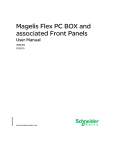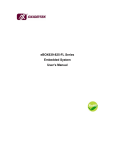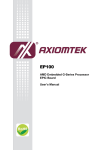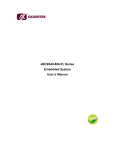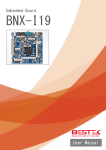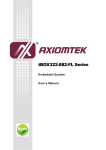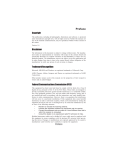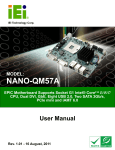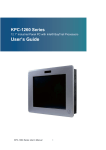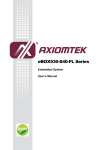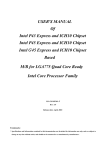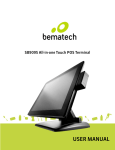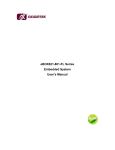Download eBOX638-840-FL User`s Manual VA1
Transcript
eBOX638-840-FL Series Embedded System User’s Manual Disclaimers This manual has been carefully checked and believed to contain accurate information. Axiomtek Co., Ltd. assumes no responsibility for any infringements of patents or any third party’s rights, and any liability arising from such use. Axiomtek does not warrant or assume any legal liability or responsibility for the accuracy, completeness or usefulness of any information in this document. Axiomtek does not make any commitment to update the information in this manual. Axiomtek reserves the right to change or revise this document and/or product at any time without notice. No part of this document may be reproduced, stored in a retrieval system, or transmitted, in any form or by any means, electronic, mechanical, photocopying, recording, or otherwise, without the prior written permission of Axiomtek Co., Ltd. Copyright 2015 Axiomtek Co., Ltd. All Rights Reserved December 2015, Version A2 Printed in Taiwan ii Safety Precautions Before getting started, please read the following important safety precautions. 1. The eBOX638-840-FL does not come equipped with an operating system. An operating system must be loaded first before installing any software into the computer. 2. Be sure to ground yourself to prevent static charge when installing the internal components. Use a grounding wrist strap and place all electronic components in any static-shielded devices. Most electronic components are sensitive to static electrical charge. 3. Disconnect the power cord from the eBOX638-840-FL before making any installation. Be sure both the system and the external devices are turned OFF. Sudden surge of power could ruin sensitive components. Make sure the eBOX638-840-FL is properly grounded. 4. Make sure the voltage of the power source is correct before connecting the equipment to the power outlet. 5. Turn OFF the system power before cleaning. Clean the system using a cloth only. Do not spray any liquid cleaner directly onto the screen. 6. Do not leave this equipment in an uncontrolled environment where the storage temperature is below -20℃ or above 80℃. It may damage the equipment. 7. Do not open the system’s back cover. If opening the cover for maintenance is a must, only a trained technician is allowed to do so. Integrated circuits on computer boards are sensitive to static electricity. To avoid damaging chips from electrostatic discharge, observe the following precautions: Before handling a board or integrated circuit, touch an unpainted portion of the system unit chassis for a few seconds. This will help to discharge any static electricity on your body. When handling boards and components, wear a wrist-grounding strap, available from most electronic component stores. iii Classification 1. 2. 3. 4. iv Degree of production against electric shock : not classified Degree of protection against the ingress of water : IP30 Equipment not suitable for use in the presence of a flammable anesthetic mixture with air or with oxygen or nitrous oxide. Mode of operation : Continuous General Cleaning Tips You may need the following precautions before you begin to clean the computer. When you clean any single part or component for the computer, please read and understand the details below fully. When you need to clean the device, please rub it with a piece of dry cloth. 1. Be cautious of the tiny removable components when you use a vacuum cleaner to absorb the dirt on the floor. 2. Turn the system off before you start to clean up the component or computer. 3. Never drop the components inside the computer or get circuit board damp or wet. 4. Be cautious of all kinds of cleaning solvents or chemicals when you use it for the sake of cleaning. Some individuals may be allergic to the ingredients. 5. Try not to put any food, drink or cigarette around the computer. Cleaning Tools: Although many companies have created products to help improve the process of cleaning your computer and peripherals users can also use household items to clean their computers and peripherals. Below is a listing of items you may need or want to use while cleaning your computer or computer peripherals. Keep in mind that some components in your computer may only be able to be cleaned using a product designed for cleaning that component, if this is the case it will be mentioned in the cleaning. Cloth: A piece of cloth is the best tool to use when rubbing up a component. Although paper towels or tissues can be used on most hardware as well, we still recommend you to rub it with a piece of cloth. Water or rubbing alcohol: You may moisten a piece of cloth a bit with some water or rubbing alcohol and rub it on the computer. Unknown solvents may be harmful to the plastics parts. Vacuum cleaner: Absorb the dust, dirt, hair, cigarette particles, and other particles out of a computer can be one of the best methods of cleaning a computer. Over time these items can restrict the airflow in a computer and cause circuitry to corrode. Cotton swabs: Cotton swaps moistened with rubbing alcohol or water are excellent tools for wiping hard to reach areas in your keyboard, mouse, and other locations. Foam swabs: Whenever possible it is better to use lint free swabs such as foam swabs. Note: We strongly recommended that you should shut down the system before you start to clean any single components. Please follow the steps below: 1. 2. 3. 4. 5. Close all application programs Close operating software Turn off power switch Remove all device Pull out power cable v Scrap Computer Recycling If the computer equipment’s needs the maintenance or are beyond repair, we strongly recommended that you should inform your Axiomtek distributor as soon as possible for the suitable solution. For the computers that are no longer useful or no longer working well, please contact your Axiomtek distributor for recycling and we will make the proper arrangement. Trademarks Acknowledgments Axiomtek is a trademark of Axiomtek Co., Ltd. IBM, PC/AT, PS/2, VGA are trademarks of International Business Machines Corporation. ® ® Intel and Pentium are registered trademarks of Intel Corporation. MS-DOS, Microsoft C and QuickBasic are trademarks of Microsoft Corporation. Windows 8, Windows 7, Windows XPE, Windows XP, Windows WinCE embedded, Linux, MS-DOS, Microsoft C and Other brand names and trademarks are the properties and registered brands of their respective owners. vi Table of Contents Disclaimers .............................................................................................................. ii Safety Precautions ................................................................................................. iii Classification .......................................................................................................... iv General Cleaning Tips ............................................................................................ v Scrap Computer Recycling.................................................................................... vi CHAPTER 1 INTRODUCTION ................................................................................. 1 1.2 System Specifications............................................................................ 2 1.2.1 1.2.2 1.2.3 1.2.4 1.3 CPU ......................................................................................................... 2 I/O System .............................................................................................. 2 System Specification ............................................................................ 3 Driver CD Content ................................................................................. 3 Dimensions ............................................................................................... 4 1.3.1 1.3.2 System Dimension ................................................................................ 4 Wall mount Bracket Dimension ........................................................... 5 1.4 I/O Outlets .................................................................................................. 6 1.5 Packing List .............................................................................................. 8 1.6 Model List .................................................................................................. 8 CHAPTER 2 HARDWARE INSTALLATION .......................................................... 9 2.1 Installing the Memory Module .............................................................. 9 2.2 Installing the Express Mini Card ....................................................... 10 2.3 Installing the 2.5” SATA HDD ............................................................. 12 2.4 Installing the PCI / PCIe x1 Card ....................................................... 15 CHAPTER 3 JUMPER SETTING & CONNECTOR ............................................ 17 3.1 Board Layout .......................................................................................... 17 3.2 Jumper Setting Summary.................................................................... 18 3.2.1 3.2.2 3.2.3 3.3 Clear CMOS (CLR_CMOS) .................................................................. 19 COM RI/+5V/+12V Select (COM_RI) ................................................... 19 SATA DOM Power Select (SATA_P7) ................................................. 19 Connectors .............................................................................................. 20 3.3.1 3.3.2 3.3.3 3.3.4 3.3.5 3.3.6 3.3.7 3.3.8 DC-in Phoenix Power Connector ....................................................... 20 ATX Power On/OFF Button ................................................................. 20 PS/2 Keyboard and Mouse Connector .............................................. 21 COM Serial Port Connector ................................................................ 21 VGA Connector .................................................................................... 22 HDMI Connector .................................................................................. 22 LAN Connector (LAN1, LAN2) ............................................................ 23 USB 2.0 Connector .............................................................................. 23 vii 3.3.9 3.3.10 3.3.11 3.3.12 USB 3.0 Internal Connector ................................................................ 24 Audio Connector ................................................................................. 24 SATA Connector .................................................................................. 25 Express Mini Card Slot ....................................................................... 26 CHAPTER 4 BIOS SETUP UTILITY ..................................................................... 27 viii 4.1 Starting ..................................................................................................... 27 4.2 Navigation Keys ..................................................................................... 27 4.3 Main Menu ............................................................................................... 28 4.4 Advanced Menu ..................................................................................... 29 4.5 Chipset Menu .......................................................................................... 41 4.6 Boot Menu ............................................................................................... 44 4.7 Security Menu ......................................................................................... 46 4.8 Save & Exit Menu ................................................................................... 47 eBOX638-840-FL Series User’s Manual CHAPTER 1 INTRODUCTION This chapter contains general information and detailed specifications of the eBOX638-840-FL. The Chapter 1 includes the following sections: 1.1 General Description System Specification Dimensions I/O Outlets Package List General Description The eBOX638-840-FL is an embedded system that supports onboard Intel® Celeron™ J1900 SoC (2M Cache, up to 2.42 GHz) processors to provide Windows 8, Windows 7, Windows Embedded 8, Windows Embedded 7, Linux, suitable for the most endurable operation. It features fan less design with full feature I/O, one 204-pin unbuffered SO-DIMM socket for singe channel DDR3L-1333/1066 MHz memory, and enhanced system dependability by builtin Watchdog Timer. Features 1. Intel® Celeron™ J1900 Quad core SoC 2. Maximum to 8GB DDR3L SO-DIMM-1333/1066 MHz memory 3. Support two 32bit/33MHz PCI slots (Max. length of 200 mm of PCB boards expansion, total 10W) or two PCIe x1 slots( total 18W) by selection. 4. Supports 4 USB 2.0 ports and 1 internal USB 3.0 port 5. Supports 6 RS-232 ports 6. Supports dual 10/100/1000Mbps Ethernet ports 7. Supports HDMI and VGA ports 8. One 2.5” SATA HDD drive bay 9. One Full-size PCI Express Mini Card (mSATA or PCIe Mini Card) 10. One PS/2 keyboard port and mouse port 11. Two SMA antenna opening 12. One Audio (Mic-in / Line-out) 13. Watchdog timer (Reset, 1~255 sec) 14. 16~28VDC wide range power input 15. Wall mount (optional) 16. Express Mini Card Module (optional) 17. Antenna (optional) Introduction 1 eBOX638-840-FL Series User’s Manual Reliable and Stable Design The eBOX638-840-FL adopts the advanced cooling system and supporting the 2.5” HDD/SSD, which makes it especially suitable for vibration environments, best for industrial automation, digital signage and gaming application. Embedded O.S. Supported The eBOX638-840-FL not only supports Windows 7 & 8, but also supports embedded OS, such as Windows 7 embedded, Windows 8 embedded and Linux. 1.2 System Specifications 1.2.1 CPU CPU Onboard Intel® Celeron™ J1900 Quad core SoC processor (2M Cache, up to 2.42 GHz) BIOS AMI 64Mb SPI ROM. System Memory Maximum to 8GB DDR3L 1333/1066 MHz memory One 204-pin DDR3L SO-DIMM sockets 1.2.2 I/O System 1 x VGA (Supports max resolution 2560x1600@60Hz) 1 x HDMI (Supports max resolution 1920x1080@60Hz) 5 x RS-232 ports and 1 x RS-232 port with 5V/12V power 1 x Audio (Mic-in/Line-out) with Realtek ALC269 1 x PS/2 Keyboard 1 x PS/2 Mouse 2 x 10/100/1000Mbps RJ45 Realtek RTL8111G Ethernet 4 x USB 2.0 & 1 x internal USB 3.0 2 x SMA opening for antenna 1 x 2.5” HDD/SSD driver bay (3Gb/s performance) 1 x 16~28VDC power input connector 2 x 32bit/33MHz PCI or 2 x PCIe x1 slots(Total max 10W for usage) Or 2 x PCIe x1 slots (Total max 18W for usage) 2 Introduction eBOX638-840-FL Series User’s Manual 1.2.3 System Specification Watchdog Timer Reset supported; 255 levels, 1~255 sec. Internal Power Supply DC ATX 72W Input: DC 16~28VDC Output: +12V@6A for Main board Operation Temperature -10℃ ~ 55℃ (14 ºF ~ 131ºF), J1900 with W .T. SSD/DRAM Storage Temperature -20℃ ~ 80℃ (-4 ºF ~ 176ºF) Humidity 10% ~ 90% (non-condensation) Vibration Endurance 2Grm w/ SSD(5-500Hz, X, Y, Z directions) Weight 4.1 kg (9.03 lb) without package 4.8 kg (10.58 lb) with package Dimensions 192mm(7.56”) (W) x 230mm(9.05”) (D) x 130.8mm(5.14”) (H) 1.2.4 Driver CD Content Driver Audio Driver Chipset Driver Ethernet Driver Graphic Driver Manual User Manual Quick Manual Note: All specifications and images are subject to change without notice. Introduction 3 eBOX638-840-FL Series User’s Manual 1.3 Dimensions The following diagrams show you dimensions and outlines of the eBOX638-840-FL. 1.3.1 4 System Dimension Introduction eBOX638-840-FL Series User’s Manual 1.3.2 Wall mount Bracket Dimension Introduction 5 eBOX638-840-FL Series User’s Manual 1.4 I/O Outlets The following figures show you I/O outlets on front view of the eBOX638-840-FL. Front View Front View drawing 6 Introduction eBOX638-840-FL Series User’s Manual Rear View Rear View drawing Introduction 7 eBOX638-840-FL Series User’s Manual 1.5 Packing List The package bundled with your eBOX638-840-FL should contain the following items: eBOX638-840-FL System Unit x 1 eBOX638-840-FL Quick Manual x 1 CD x 1 (For Driver and User’s Manual) Screws pack x1 Foot pad x4 Mini Card Modules (Optional) Wall-mount Brackets (optional) HDD/SSD (optional) DDR3L DRAM (optional) Note: If you cannot find this package or any items are missing, please contact Axiomtek distributors immediately. 1.6 Model List eBOX638-840-FL-2PCI-DC Fanless Embedded System with Intel® Celeron® Processor J1900 2.0 GHz, VGA/HDMI , 6 COM, 2 PCI slots and 16~28VDCInput eBOX638-840-FL-2PCIe-DC Fanless Embedded System with Intel® Celeron® Processor J1900 2.0 GHz, VGA/HDMI , 6 COM, 2 PCIe x1slots and 16~28VDCInput If you cannot find this package or any items are missing, please contact Axiomtek distributors immediately. 8 Introduction eBOX638-840-FL Series User’s Manual CHAPTER 2 HARDWARE INSTALLATION The eBOX638-840-FL is convenient for your various hardware configurations, such as Memory Module, HDD (Hard Disk Drive), SSD (Solid State Drive) and mSATA. The chapter 2 will show you how to install the hardware. 2.1 Installing the Memory Module Step 1 Turn off the system, and unplug the power cord. Step 2 Locate screws at the top side, loosen screws. Step 3 Remove the top cover. Hardware Installation 9 eBOX638-840-FL Series User’s Manual Step 4 Locate the memory module, insert the gold colored contact into the socket. Push the module down, until it is firmly seated by locking two latches on the sides. Step 5 Close the cover to the chassis, and fasten all screws. 2.2 Installing the Express Mini Card Step 1 Turn off the system, and unplug the power cord. Step 2 Locate screws at the top side, loosen screws. Step 3 Remove the top cover. 10 Hardware Installation eBOX638-840-FL Series User’s Manual Step 4 Locate the location of Mini card slot. Step 5 Slide Mini card into Mini Card slot with caution then fasten screw. Step 6 Assembly the top cover back and fasten all screws. Note: In likely conditions, user may have to replace new thermal pads or grease when existing thermal pad/grease are damaged, dirty or missed. Check the accessory kit for the need. Hardware Installation 11 eBOX638-840-FL Series User’s Manual 2.3 Installing the 2.5” SATA HDD Step 1 Turn off the system, and unplug the power cord. Step 2 Locate screws at the top side, loosen screws. Step 3 Locate screws at the back side, loosen screws. Step 4 Remove the top cover 12 Hardware Installation eBOX638-840-FL Series User’s Manual Step 5 Remove the rear cover Step 6 Loosen screws and pull out the HDD bracket. Step 7 Assembly the HDD bracket together with the SATA HDD . Step8 Install the HDD tray into tray bracket. Hardware Installation 13 eBOX638-840-FL Series User’s Manual Step 9 Fasten screws and connect SATA cable and power cable to SATA HDD. Step 10 Assemble the rear cover and top cover back to the chassis, and fasten all screws. 14 Hardware Installation eBOX638-840-FL Series User’s Manual 2.4 Installing the PCI/PCIe x1 Card Step 1 Turn off the system. Step 2 Unplug the power-cord. Step 3 Turning leftward to loosen the button as marked; next, pull the lower left cover out. Step 4 You can locate the PCI or PCIe x1 slot from the side. Step 5 Align the PCI or PCIe x1 card with the slot, and press the card into the slot until it is firmly seated. Hardware Installation 15 eBOX638-840-FL Series User’s Manual Step 6 16 Close the side cover to the chassis and fasten the button. Hardware Installation eBOX638-840-FL Series User’s Manual CHAPTER 3 JUMPER SETTING & CONNECTOR Proper jumper settings configure the eBOX638-840-FL to meet your application purpose. We are herewith listing a summary table of all jumpers and default settings for onboard devices, respectively. 3.1 Board Layout Note: We strongly recommended that you should not modify any unmentioned jumper setting without Axiomtek FAE’s instruction. Any modification without instruction might cause system to become damage. Jumper Setting & Connector 17 eBOX638-840-FL Series User’s Manual 3.2 Jumper Setting Summary Proper jumper settings configure the eBOX638-840-FL to meet your application purpose. We are herewith listing a summary table of all jumpers and default settings for onboard devices, respectively. Jumper Description Setting CLR_CMOS Clear CMOS Default: Normal Operation 1-2 Close COM_RI COM RI/+5V/+12V Select Default: RI 3-4 Close SATA_P7 SATA DOM Power Select Default: GND 1-2 Close Note: How to setup Jumpers The illustration shows how to set up jumpers. When the jumper cap is placed on pins, the jumper is “close”, if not, that means the jumper is “open”. [Open] 18 [Closed] [Pin1 -2 Closed] Jumper Setting & Connector eBOX638-840-FL Series User’s Manual 3.2.1 Clear CMOS (CLR_CMOS) This jumper allows you to clear the Real Time Clock (RTC) RAM in CMOS. You can clear the CMOS memory of date, time, and system setup parameters by erasing the CMOS RTC RAM data. The onboard button cell battery powers the RAM data in CMOS, which includes system setup information such as system passwords. To erase the RTC RAM: 1. Turn OFF the computer and unplug the power cord. 2. Remove the onboard battery. 3. Move the jumper clip from pins 1-2 (default) to pins 2-3. Keep the clip on pins 2-3 for about 5~10 seconds, then move the clip back to pins 1-2. 4. Re-install the battery. 5. Plug the power cord and turn ON the computer. 6. Hold down the <Del> key during the boot process and enter BIOS setup to re-enter data. Except when clearing the RTC RAM, never remove the clip on this jumper default position. Removing the clip will cause system boot failure! Caution Function Setting Normal operation (Default) Clear CMOS 1-2 close 2-3 close Note: 3.2.2 You do not need to clear the RTC when the system hangs due to overclocking. For system failure due to overclocking, use the C.P.R. (CPU Parameter Recall) feature. Shut down and reboot the system so the BIOS can automatically reset parameter settings to default values. COM RI/+5V/+12V Select (COM_RI) This jumper allows you to select the power mode of COM3 port. Function +12V RI (Default) +5V 3.2.3 Setting 1-2 close 3-4 close 5-6 close SATA DOM Power Select (SATA_P7) This jumper allows you to select the power mode of SATA DOM. Function Setting GND (Default) +5V 1-2 close 2-3 close Jumper Setting & Connector 19 eBOX638-840-FL Series User’s Manual 3.3 Connectors Connectors connect the board with other parts of the system. Loose or improper connection might cause problems. Make sure all connectors are properly and firmly connected. Here is a summary table shows you all connectors and button on the eBOX638-840-FL Series. External Connectors / Buttons Section DC-in Phoenix Power Connector 3.3.1 ATX Power On/Off Button 3.3.2 PS/2 Keyboard and Mouse Connector 3.3.3 COM Serial Port Connector 3.3.4 VGA Connector 3.3.5 HDMI Connector 3.3.6 LAN Connector(LAN1,LAN2) 3.3.7 USB 2.0 Connector 3.3.8 USB 3.0 Internal Connector 3.3.9 Audio Connector 3.3.10 SATA Connector 3.3.11 Mini Card Slot 3.3.12 3.3.1 DC-in Phoenix Power Connector The system supports a wide range Phoenix DC -in connector for system power input. Pin Signal 1 DC+ 2 GND 3 DC- 3.3.2 ATX Power On/OFF Button The ATX power button is on the I/O side. It can allow users to control eBOX638-840-FL power on/off. Pin Signal 1 GND 1 2 PSIN 2 20 Jumper Setting & Connector eBOX638-840-FL Series User’s Manual 3.3.3 PS/2 Keyboard and Mouse Connector eBOX638-840-FL provides a keyboard and Mouse interface with a DIN connector. To install the PS/2 keyboard and mouse, plug the mouse to the upper port (green), and the keyboard to the lower port (purple). Pin Signal Pin Signal 1 K/B Data 7 M/S Data 2 NC 8 NC 3 GND 9 GND 4 VCC 10 VCC 5 K/B CLK 11 M/S CLK 6 NC 12 NC 12 10 11 9 8 7 3.3.4 6 4 5 3 2 1 COM Serial Port Connector Please refer to the following pin define for COM1 to COM6. COM3 supports RS-232 port with 5V/12V power by jumper selection and power will output through Pin9. Pin 1 2 3 4 5 6 7 8 9 Description DCD, Data Carrier Detect RXD, Receive Data TXD, Transmit Data DTR, Data Terminal Ready GND, Ground DSR, Data Set Ready RTS, Request To Send CTS, Clear To Send RI, Ring Indicator Jumper Setting & Connector COM1~COM6 21 eBOX638-840-FL Series User’s Manual 3.3.5 VGA Connector The VGA connector is a slim type 15-pin D-Sub connector which is common for the CRT VGA display. The VGA interface configuration can be configured via the software utility. Pin Signal Pin Signal Pin Signal 1 Red 2 Green 3 Blue 4 N.C. 5 GND 6 DETECT 7 GND 8 GND 9 VCC 10 GND 11 N.C. 12 DDC DATA 13 Horizontal Sync 14 Vertical Sync 15 DDC CLK 3.3.6 HDMI Connector The HDMI is a compact digital interface which is capable of transmitting high-definition video and high-resolution audio over a single cable. Pin Pin Signal 1 HDMI OUT_DATA2+ 11 GND 2 GND 12 HDMI OUT Clock- 3 HDMI OUT_DATA2- 13 N.C. 4 HDMI OUT_DATA1+ 14 N.C. 5 GND 15 HDMI OUT_SCL 6 HDMI OUT_DATA1- 16 HDMI OUT_SDA 7 HDMI OUT_DATA0+ 17 GND 8 GND 18 +5V 9 HDMI OUT_DATA0- 19 HDMI_HTPLG 10 22 Signal HDMI OUT Clock+ Jumper Setting & Connector eBOX638-840-FL Series User’s Manual 3.3.7 LAN Connector (LAN1, LAN2) The RJ-45 connector is for Ethernet. To connect the board to a 1000/100/10 Base-T hub, just plug one end of the cable into connector and connect the other end (phone jack) to a 1000/100/10-Base-T hub Pin Signal Pin Signal L1 MDI0+ L5 MDI2- L2 MDI0- L6 MDI1- L3 MDI1+ L7 MDI3+ L4 MDI2+ L8 MDI3- A B 3.3.8 A B 100 LAN LED (Green)/ 1000 LAN LED (Orange) Active LED (Yellow) USB 2.0 Connector The Universal Serial Bus connectors are compliant with USB 2.0 (480Mbps), and ideally for installing USB peripherals such as keyboard, mouse, scanner, etc. Pin Signal USB Port 0 Pin Signal USB Port 1 1 USB VCC (+5V level) 5 USB VCC (+5V level) 2 USB #0_D- 6 USB #1_D- 3 USB #0_D+ 7 USB #1_D+ 4 Ground (GND) 8 Ground (GND) 5 6 7 8 Jumper Setting & Connector 1 2 3 4 23 eBOX638-840-FL Series User’s Manual 3.3.9 USB 3.0 Internal Connector This internal connector provides USB Rev. 3.0 supporting transmission rate up to 5Gbps and fuse protect. Pin Signal 1 2 3 4 5 6 7 8 9 VCC -DATA1 +DATA1 GND -SRX1 +SRX1 GND -STX1 +STX1 3.3.10 Audio Connector These two audio jacks ideal are for Audio Mic-In and Audio Line-out. Pin Signal 1 Line Out 2 Microphone In 1 2 24 Jumper Setting & Connector eBOX638-840-FL Series User’s Manual 3.3.11 SATA Connector The SATA connector is for high-speed SATA interface ports and they can be connected to hard disk devices. Pin Signal 1 GND 2 SATA_TX+ 3 SATA_TX- 4 GND 5 SATA_RX- 6 SATA_RX+ 7 GND Note: Please notice that eBOX638-840 shares SATA signal for SATA 2 connector and mSATA, thus please don’t connect your storage to SATA2 if you connect mSATA already. The system always can’t detect SATA2 device once mSATA device is connected. Jumper Setting & Connector 25 eBOX638-840-FL Series User’s Manual 3.3.12 Express Mini Card Slot PCI Express Mini Card connector supports a PCI Express x1 link and a USB 2.0 link. 26 Pin Signal Pin Signal 1 3 5 7 9 11 13 15 17 19 21 23 25 27 29 31 33 35 37 39 41 43 45 47 49 51 W AKE# No use No use CLKREQ# GND REFCLKREFCLK+ GND No use No use GND PE_RXN3 PE_RXP3 GND GND PE_TXN3 PE_TXP3 GND GND +3.3VSB +3.3VSB GND No use No use No use No use 2 4 6 8 10 12 14 16 18 20 22 24 26 28 30 32 34 36 38 40 42 44 46 48 50 52 +3.3VSB GND +1.5V No use No use No use No use No use GND No use PERST# +3.3VSB GND +1.5V SMB_CLK SMB_DATA GND USB_D8USB_D8+ GND No use No use No use +1.5V GND +3.3VSB Jumper Setting & Connector eBOX638-840-FL Series User’s Manual CHAPTER 4 BIOS SETUP UTILITY This chapter provides users with detailed description how to set up basic system configuration through the BIOS setup utility. 4.1 Starting To enter the setup screens, follow the steps below: 1. Turn on the computer and press the <Del> key immediately. 2. After you press the <Del> key, the main BIOS setup menu displays. You can access the other setup screens from the main BIOS setup menu, such as the Advanced and Chipset menus. It is strongly recommended that you should avoid changing the chipset’s defaults. Both AMI and your system manufacturer have carefully set up these defaults that provide the best performance and reliability. 4.2 Navigation Keys The BIOS setup/utility uses a key-based navigation system called hot keys. Most of the BIOS setup utility hot keys can be used at any time during the setup navigation process. These keys include <F1>, <F2>, <Enter>, <ESC>, <Arrow> keys, and so on. Note: Some of the navigation keys differ from one screen to another. Hot Keys Description Left/Right The Left and Right <Arrow> keys allow you to select a setup screen. Up/Down The Up and Down <Arrow> keys allow you to select a setup screen or subscreen. + Plus/Minus The Plus and Minus <Arrow> keys allow you to change the field value of a particular setup item. Tab The <Tab> key allows you to select setup fields. F1 The <F1> key allows you to display the General Help screen. F2 The <F2> key allows you to Load Previous Values. F3 The <F3> key allows you to Load Optimized Defaults. F4 The <F4> key allows you to save any changes you have made and exit Setup. Press the <F4> key to save your changes. Esc The <Esc> key allows you to discard any changes you have made and exit the Setup. Press the <Esc> key to exit the setup without saving your changes. Enter The <Enter> key allows you to display or change the setup option listed for a particular setup item. The <Enter> key can also allow you to display the setup sub- screens. BIOS Setup Utility 27 eBOX638-840-FL Series User’s Manual 4.3 Main Menu The first time you enter the setup utility, you will enter the Main setup screen. You can always return to the Main setup screen by selecting the Main tab. System Time/Date can be set up as described below. The Main BIOS setup screen is shown below. BIOS Information Display the auto-detected BIOS information. System Date/Time Use this option to change the system time and date. Highlight System Time or System Date using the <Arrow> keys. Enter new values through the keyboard. Press the <Tab> key or the <Arrow> keys to move between fields. The date must be entered in MM/DD/YY format. The time is entered in HH:MM:SS format. Access Level Display the access level of current user. 28 BIOS Setup Utility eBOX638-840-FL Series User’s Manual 4.4 Advanced Menu Launch PXE OpROM Use this item to enable or disable the boot ROM function of the onboard LAN chip when the system boots up. The Advanced menu also allows users to set configuration of the CPU and other system devices. You can select any of the items in the left frame of the screen to go to the sub menus: ► ► ► ► ► ► ► ► ► ► ► ACPI Settings RTC Wake Settings CPU Configuration SATA Configuration Intel IGD SWSCI OpRegion USB Configuration Super IO Configuration H/W Monitor TXE Configuration Trusted Computing DIO Configuration For items marked with “”, please press <Enter> for more options. BIOS Setup Utility 29 eBOX638-840-FL Series User’s Manual ACPI Settings You can use this screen to select options for the ACPI configuration, and change the value of the selected option. A description of the selected item appears on the right side of the screen. ACPI Sleep State Select the highest ACPI sleep state the system will enter when the suspend button is pressed. Configuration options are Suspend Disabled and S3 (Suspend to RAM). 30 BIOS Setup Utility eBOX638-840-FL Series User’s Manual RTC Wake Settings Wake system with Fixed Time Enable or disable system wake on alarm even. When enabled, system will wake upon the hr/min/sec specified. BIOS Setup Utility 31 eBOX638-840-FL Series User’s Manual CPU Configuration This screen shows the CPU information. 32 BIOS Setup Utility eBOX638-840-FL Series User’s Manual SATA Configuration In this Configuration menu, you can see the currently installed hardware in the SATA ports. During system boot up, the BIOS automatically detects the presence of SATA devices. SATA Mode Determine how SATA controller(s) operate. Operation mode options are Disabled, IDE Mode and AHCI Mode. BIOS Setup Utility 33 eBOX638-840-FL Series User’s Manual USB Configuration You can use this screen to select options for the USB Configuration, and change the value of the selected option. A description of the selected item appears on the right side of the screen. USB Devices Display all detected USB devices. Legacy USB Support Enable or disable support for USB device on legacy operating system. The default setting is Enabled. Auto option disables legacy support if no USB devices are connected. Disable option will keep USB devices available only for EFI applications. XHCI Mode Enable option allow XHCI mode support. Disable option will keep XHCI mode disable. Auto option will auto detect which mode is better. Smart auto option will auto detect the suitable mode for device plugged. 34 BIOS Setup Utility eBOX638-840-FL Series User’s Manual Super IO Configuration You can use this screen to select options for the Super IO Configuration, and change the value of the selected option. A description of the selected item appears on the right side of the screen. For items marked with “”, please press <Enter> for more options. Serial Port 1~6 Configuration Set parameters of serial port 1 (COM1) ~ serial port 6 (COM6). Change settings Select an optimal setting for super IO device. Parallel Port Configuration Set parameters of LPT port. (eBOX638-840-FL doesn’t support it for default version) Change settings Select an optimal setting for super IO device. Restore AC Power Loss Set the state after power loss. BIOS Setup Utility 35 eBOX638-840-FL Series User’s Manual Watch Dog Timer Select watchdog count mode second/minute. Watch Dog Timer Time Out Value Timer will start to count from end of POST. 00 - Time out Disable. H/W Monitor Use this screen for Smart Fan configuration and hardware health status monitoring. This screen displays the temperature of system and CPU, cooling fan speed in RPM and system voltages (CPU VCORE, 5V, 5VSB, 12V and 3.3V). Smart Fan Function Select CPU fan mode. When this feature is set to automatic the CPU’s fan speed will rotate according to the CPU’s temperature; the higher the temperature, the faster the speed of rotation. Smart Fan Mode Configuration Select Manual mode or Thermal Cruise mode. 36 BIOS Setup Utility eBOX638-840-FL Series User’s Manual TXE Configuration Enable or disable TXE firmware. BIOS Setup Utility 37 eBOX638-840-FL Series User’s Manual Trusted Computing Security Device Support Enable or disable BIOS support for security device. 38 BIOS Setup Utility eBOX638-840-FL Series User’s Manual DIO Configuration Allow user to check digital input 1~4 port state and set digital output 5~8 port setting. (eBOX638-840-FL doesn’t support it for default version) BIOS Setup Utility 39 eBOX638-840-FL Series User’s Manual 40 EUP Function BIOS Setup Utility eBOX638-840-FL Series User’s Manual 4.5 Chipset Menu The Chipset menu allows users to change the advanced chipset settings. You can select any of the items in the left frame of the screen to go to the sub menus: ► North Bridge ► South Bridge For items marked with “”, please press <Enter> for more options. BIOS Setup Utility 41 eBOX638-840-FL Series User’s Manual North Bridge This screen is for North Bridge configuration. DVMT Total Gfx Mem When set to Max Mode, the graphics driver will reserve a Max. of system memory as graphics memory, according to system and graphics requirement DVMT Pre-Allocated Select DVMT pre-allocated graphics memory size used by the internal graphics device (IGD). Initiate Graphic Adapter Set initial graphic adapter. Please notice that eBOX638-840-FL supports Internal graphics only. 42 BIOS Setup Utility eBOX638-840-FL Series User’s Manual South Bridge LAN 1/2 Controller Enable or disable onboard LAN1/LAN2 controller. Azalia HD Audio Enable or disable onboard HD Audio controller. Azalia Internal HDMI Codec Enable or disable onboard Audio internal HDMI controller. Resume from LAN1/2 Enable or disable resume from LAN1/LAN2 function. Resume from WAK# / RING Enable or disable COM port WAK#/RING function. BIOS Setup Utility 43 eBOX638-840-FL Series User’s Manual 4.6 Boot Menu The Boot menu allows users to change boot options of the system. Operation System Select Select which OS would be installed. Configuration options are Windows 7 or other OS, Windows 8.x, Windows 8.x with CSM and Manual. Quiet Boot Enable or disable Quiet Boot mode. Fast Boot Enable or disable Fast Boot mode. Setup Prompt Timeout Increasing the value will make the POST take longer; the default setting is 1 second. Bootup NumLock State Select the keyboard number lock status. 44 BIOS Setup Utility eBOX638-840-FL Series User’s Manual Boot Mode Select This item could be set to Legacy or UEFI. Set Boot Priority Set boot device priority by BIOS setting. BIOS Setup Utility 45 eBOX638-840-FL Series User’s Manual 4.7 Security Menu The Security menu allows users to change the security settings for the system. Administrator Password This item indicates whether an administrator password has been set (installed or uninstalled). User Password This item indicates whether an user password has been set (installed or uninstalled). 46 BIOS Setup Utility eBOX638-840-FL Series User’s Manual 4.8 Save & Exit Menu The Save & Exit menu allows users to load your system configuration with optimal or fail-safe default values. Save Changes and Exit Exit system setup after saving the changes. Discard Changes and Exit Exit system setup without saving the changes. Restore Defaults Restore/load default values for all the setup option. BIOS Setup Utility 47 eBOX638-840-FL Series User’s Manual This page is intentionally left blank. 48 BIOS Setup Utility


























































